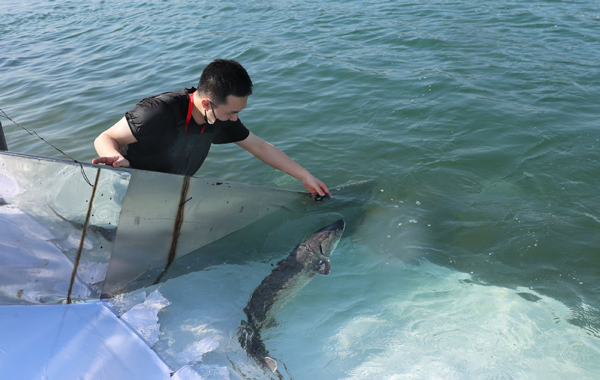
WUHAN — Approximately 230,000 captive-bred Chinese sturgeon were released into the Yangtze River on April 9 to help restore the species' wild population.
The fish were released in the city of Yichang, Central China's Hubei province, in the 65th sturgeon release event carried out by the China Three Gorges Corporation (CTGC).
The number of sturgeon released hit a record high, and the CTGC has so far released nearly 5.3 million Chinese sturgeon into the Yangtze River.
"When patrolling the river, I often see a large number of newborn fry. The number of aquatic creatures in the Yangtze River is recovering at a significant pace," said Yan Jin, a local police officer.
Nicknamed "aquatic pandas," Chinese sturgeon have existed for more than 140 million years. However, the population of the species in the Yangtze plummeted in the late 20th century due to intrusive human activities.
"At present, it is difficult for wild Chinese sturgeon to breed, and their population is extremely endangered. The release of captive-bred sturgeon is conducive to the reproduction and recovery of the species' wild population," said Lei Mingshan, chairman of the CTGC.
The fish range in maturity from six months to 13 years, said Jiang Wei, chief engineer of the Chinese sturgeon research institute under the CTGC.
Some male fish that are 13 years old have entered sexual maturity, which was rare in previous years, Jiang said. This is important to supplementing the number of wild Chinese sturgeon and adjusting the age structure of the species.
Since the implementation of a 10-year fishing ban in pivotal waters, the Yangtze River has welcomed more aquatic creatures, but restoring the ecosystem and improving the biodiversity level are difficult things to achieve overnight, Jiang said.
"We are still racing against the clock to minimize the adverse impact that the decline in wild resources is having on the reproduction of the Chinese sturgeon population," he said.
In 2020, the Yangtze River rare fish conservation center was put into use in the Three Gorges Dam area. It has since become home to the highest number of captive-bred Chinese sturgeon in the country.
"The conservation center and the supporting Chinese sturgeon sperm and tissue cell repository are running better and better. They are like Noah's Ark for the species, and ensure that Chinese sturgeon will not go extinct easily," said Li Zhiyuan, deputy director of the Chinese sturgeon research institute.